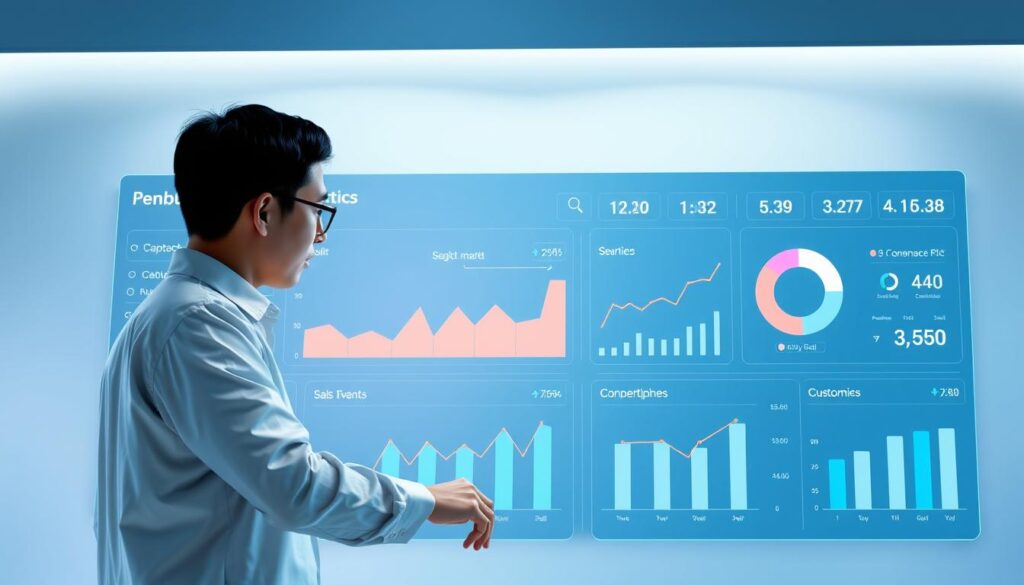Have you ever wondered why nearly 60% of employees feel disengaged at work? The answer might be in AI dashboards for performance monitoring. These tools are key for continuous feedback AI, helping leaders track employee performance and engagement.
As companies strive to do better, AI dashboards are more than a trend. They’re a must. Leaders get insights to understand their teams better, improving performance and engagement.
Key Takeaways
- AI dashboards provide essential tools for modern performance monitoring.
- Continuous feedback AI helps businesses track employee performance effectively.
- Organizations must adopt AI dashboards to enhance workforce engagement.
- Actionable insights from AI help leaders make informed decisions.
- Improved performance management leads to a more effective organization.
- Understanding employee needs is crucial for organizational success.
Understanding AI Dashboards for Performance Monitoring
AI dashboards are a game-changer in performance monitoring AI. They act as a central spot for viewing and analyzing important performance metrics. These dashboards are made for HR analytics, pulling data from different sources. This way, HR teams get real-time insights that help meet their goals.
Good AI dashboards for HR focus on key performance indicators (KPIs) for each department. They have an easy-to-use interface, helping HR make quick decisions. This makes it easier to see trends and patterns, leading to better employee engagement and support for strategic plans.
Companies using AI dashboards see big improvements in their work. These dashboards make data easy to see and help HR teams find insights that shape important strategies.
| Feature | Importance |
|---|---|
| Real-Time Data | Provides immediate insights for better decision-making. |
| Customizable KPIs | Ensures relevance to specific departmental needs. |
| User-Friendly Interface | Enhances usability and encourages frequent use by HR personnel. |
| Integrative Capability | Consolidates various data sources into one view. |
| Trend Visualization | Enables identification of performance patterns over time. |
The Importance of Continuous Performance Monitoring
Continuous performance monitoring is key to making organizations better. It uses real-time data to give feedback quickly. This helps spot and fix performance issues early on.
It makes workers feel more connected and appreciated. This is because they know their efforts are being watched and valued.
Leaders see the value in keeping an eye on performance all the time. It helps them understand what training is needed and who’s ready for new challenges. This way, everyone grows and works better together.
It also helps avoid unfair judgments in reviews. This fairness leads to better promotions and pay. When everyone feels treated fairly, the whole team does better.

Key Features of Effective AI Dashboards
An effective AI dashboard has many features that help monitor performance. It includes clear performance metrics that match the organization’s goals. It also updates data in real-time, giving users current insights for quick decisions.
Customization options for different roles make the dashboard more useful. This way, everyone can focus on what matters most to them.
The design of AI dashboards is key to keeping users interested. They should look good and be easy to use. This makes it simple for users to find the information they need.
Being able to compare current data with past performance adds value. It helps users understand trends and make better decisions.
Having good filtering tools helps users narrow down data. This makes analyzing data easier and more meaningful. All these features together make the dashboard more useful and help in making better decisions.
| Feature | Description | Benefits |
|---|---|---|
| Real-time Data Updates | Instant access to current information | Supports immediate actions and strategies |
| Customization Capabilities | Dashboard tailored to specific user roles | Improves relevancy and focus on performance metrics |
| Aesthetic Design | Visually appealing layout and intuitive navigation | Enhances user engagement and satisfaction |
| Benchmarking Tools | Comparison against historical data | Provides context and insight into performance trends |
| Filtering Options | Ability to isolate specific data sets | Makes analysis more effective and precise |
How AI Drives Performance Management & Engagement
AI technologies greatly improve performance management by analyzing data. This analysis boosts employee engagement. AI uses data from various sources, like peer feedback and employee sentiment, to provide insights for better decision-making.
Companies can use these insights to create strategies that support employees. HR professionals spot trends in performance metrics. This helps create an environment where employees feel valued and motivated to grow.
AI in performance management changes company culture. It focuses on ongoing feedback and adaptability. This lets companies quickly meet their workforce’s needs. AI analytics help businesses develop strategies that match individual goals, leading to better performance and engagement.
| Feature | Traditional Methods | AI-Driven Approaches |
|---|---|---|
| Data Analysis | Manual, time-consuming | Real-time, automated |
| Feedback Frequency | Infrequent, periodic reviews | Continuous, ongoing feedback loops |
| Personalization | One-size-fits-all | Tailored to individual needs |
| Engagement Tracking | Retrospective assessments | Proactive engagement indicators |
Companies that use AI in performance management do more than just analyze data. They change how they interact with employees. This combination of technology and HR practices gives them a strong edge in the competitive Philippine workplace.

Benefits of Implementing AI Dashboards in HR
Using AI dashboards in HR brings many benefits. It makes data-driven decisions easier. These dashboards help analyze employee engagement and performance, making it simpler to spot trends and insights.
HR teams can now spot patterns to improve talent management. This leads to a more efficient workforce. The HR analytics benefits also mean everyone can see performance data. This creates a culture of improvement, helping teams meet their goals.
AI in HR speeds up hiring and onboarding. It can quickly review resumes and predict staffing needs. This saves time and lets HR focus on what really matters.
AI dashboards are key to growing your organization. They help HR departments improve performance and make employees happier. To learn more, check out this resource.
Metrics to Monitor with AI Dashboards
Choosing the right performance metrics is key for monitoring with AI dashboards. It helps organizations check how well employees are doing and how productive they are. Important KPIs include how happy employees are, how well they meet their goals, and feedback from peers and managers.
AI dashboards make it easy to track performance at both the company and department levels. This helps HR teams find out what employees are doing well and what they need to work on. By regularly checking these KPIs, companies can stay on track with their goals and keep their employees engaged.

| Performance Metric | Description | Importance in KPIs |
|---|---|---|
| Employee Satisfaction | Measures how happy employees are with their work environment. | High levels indicate a positive workplace, contributing to retention. |
| Goal Completion Rate | Percentage of goals achieved within a specific period. | Reflects productivity and effectiveness of teams. |
| Feedback Scores | Ratings given by peers and managers focusing on performance. | Used to identify skill gaps and training needs. |
Integrating AI Dashboards into Your Existing Systems
For businesses to get the most out of AI dashboards, it’s key to integrate them smoothly into current systems. This means making sure they work well with your HR systems and data workflows. Look for software that makes it easy to collect and show data, making things more efficient.
Getting HR staff ready for this change is crucial. Teaching them how to use these dashboards is essential. This helps them feel more comfortable and confident, leading to better adoption in the workplace.
| Integration Aspect | Considerations | Benefits |
|---|---|---|
| Data Compatibility | Ensure all existing data formats are supported | Seamless data flow between systems |
| User Training | Implement comprehensive training sessions | Increased confidence and usage of dashboards |
| Software Selection | Choose platforms that offer customizable features | Enhanced adaptability to organizational needs |
| Performance Metrics | Define key performance indicators in advance | Measure impact effectively for continuous improvement |
By tackling these integration challenges, you can make AI dashboards more effective. This will help your organization perform better overall.
Industry Examples: Asian Companies Implementing AI Dashboards
Many Asian companies are leading the way in using AI dashboards. In Singapore, firms use these tools to watch employee performance in real-time. This makes checking how well employees are doing easier and boosts their engagement.
In Japan, companies use AI dashboards to make their operations more efficient. They analyze lots of data to get insights that help make big decisions. This move has greatly improved how well they work and how happy their employees are.
These success stories show how AI can change the game in performance management in Asia. They inspire others to improve their monitoring of performance. By moving to data-driven HR, these companies see big gains in many areas.

Tips for Maximizing the Value of AI Dashboards
To get the most out of AI dashboards, organizations should take a strategic approach. Setting clear goals helps shape the dashboard’s purpose and design. Keeping data up to date is crucial for accuracy, ensuring users get the latest information.
Training users through dedicated sessions boosts their skills and confidence. This helps maximize the dashboard’s value. It also encourages users to use all the tools at their disposal.
Listening to user feedback is key in performance monitoring. It helps organizations improve the dashboard’s features and usability. This ongoing improvement leads to higher engagement and better performance monitoring.
Conclusion
The role of AI dashboards is growing in importance as performance monitoring changes. These tools help companies in the Philippines and globally. They offer real-time analysis and insights that boost employee engagement and productivity.
By adopting AI dashboards, businesses can stay ahead in performance management. They use advanced tech for monitoring and feedback. This creates a culture that values motivation and high performance among employees.
Choosing AI dashboards is a smart move for companies looking to grow. They improve operations and help achieve excellence in managing performance. This is key in today’s data-driven market.

